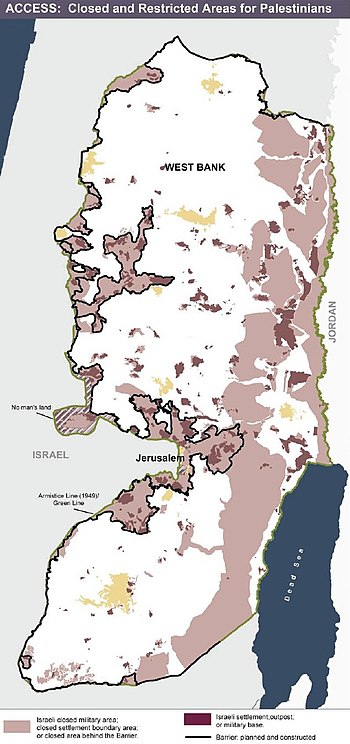 |
| English: Piece of File:Westbankjan06.jpg which is a detailed map of Israeli settlements on the West Bank, January 2006. Produced by the United Nations Office for the Coordination of Humanitarian Affairs - public UN source. Map Centre: http://www.ochaopt.org/?module=displaysection§ion_id=96&format=html (Photo credit: Wikipedia) |
Since the
end of Operation Protective Edge, the violence in Jerusalem
The same
events also stoked violence in the streets of Jerusalem ,
and the Gaza US
citizens and Israelis were wounded when a convicted Palestinian
terrorist from the east Jerusalem Israel
“The
vehicle ran over a number of people, including several Americans, as they
exited the train, and the suspect was shot when he attempted to flee the scene
by foot,” the official said, requesting anonymity until the US State Department
confirms the American casualties.“Nine people were injured, three seriously,
including an American infant who died after sustaining critical injuries,” he
continued.
The official described the suspect as a convicted terrorist who served a recent prison sentence in
On 29th
October 2014 A controversial figure, Rabbi Yehuda Glick has long advocated for
Jews to be allowed to pray at a Jerusalem holy
site known to Jews as the Temple
Mount
The blame
for this violence lies with both Palestinians and Israelis. It always takes two
to tango but in this case the results are tragic for both sides. Each side
blames the other and there does not seem to be an immediate end to the bloody
violence in sight.
The
mention of the word "Jerusalem Jerusalem
is the "Holy
City
It is very
difficult to be objective when discussing the conflict and its affects on Jerusalem Temple Mount
 |
| Violence near the Dome of the Rock |
The blame
for what is occurring in Jerusalem Israel of genocide against the Palestinian
people is jarring to Israeli ears and is viewed, especially by the right wing
sectors in Israel as a call
to blood and violence in Jerusalem
Mahmoud
Abbas has adopted the tactic of making statements to prove that he is not in
the hands of the Israelis and carrying out their policies. So he resorts to
portraying an unyielding posture towards Israel Jerusalem
will not bring peace to Jerusalem
A large
part of the blame must also be laid at the door of the extremist right-wing
settler movements who have decided to settle in Silwan and Ir David in the
heart of Palestinian East Jerusalem.The behaviour of the Netanyahu Government
has been deplorable in their attitude of supporting and encouraging settlement
in areas where Palestinians reside. This has caused much of the violence.
Housing Minister Uri Ariel (Jewish
Home) attended this evening (Thursday 23rd October 2014) the laying of a
cornerstone for the new synagogue being built in Nokdim, a new community in
the eastern part
of Gush Etzion together with Foreign Minister Avigdor Liberman
(Yisrael Beytenu) and Gush Etzion Regional Council Head Davidi Perl.
In his
speech Ariel addressed the building freeze that had been put in place throughout
Judea and Samaria , saying, "We are working
toward the removal of the building moratorium in this community and other
communities in Judea and Samaria , as well as in Jerusalem
"We
need to build, not as a response to murder, but because of the need to be
constantly building throughout Israel Jerusalem
Meanwhile the
violence continues, maybe it has been dampened a bit by the rainy season in Israel



No comments:
Post a Comment